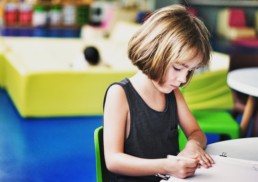By Carolyn Mee
“Children need to hear to learn but all too often undetected hearing problems cause children to fall behind during Primary School until someone thinks to have the child’s hearing checked. By the time this happens the child may not only be behind academically but may have come to deeply believe that he or she will never be able to keep up with the other children at school.” Professor Harvey Dillon, Department of Linguistics Macquarie University. 1.
In Australia, all babies have access to a hearing test at birth. The newborn hearing screening program is aimed at identifying children with moderate or greater hearing loss to ensure they receive timely intervention, such as cochlear implants or hearing aids, so they can hear in order to develop language and auditory brain function. 2
In addition to mild loss, which may not be detected by the newborn screen, there are other forms of hearing issues that can develop in the years after birth. Illness, injury and genetics can cause a child to develop debilitating hearing issues that if left untreated can have a profound impact on their life.
It may be a surprise to learn that more children are fitted with hearing aids during the first three years of school than are fitted in the first year of life. 3 This may be due to their loss being mild and hearing aids being unnecessary prior to school or it may be due to their loss going unnoticed until learning issues at school trigger investigation.
If the child’s hearing loss is due to a middle ear issue such as glue ear or wax, medical intervention may resolve the issue. It’s estimated that more than 10% of children suffer from middle ear issues and the impact of a middle ear issue can, if left untreated, be as significant as that of a permanent hearing loss.
In addition to middle ear and inner ear hearing issues there are a large number of children who have hearing disorders not in their ears, but in their brains. Dr Harvey Dillon states that ‘some of these brain-based issues are the consequence of middle ear infections the children had when they were infants, toddlers or preschoolers’.
For those children who don’t have their hearing loss identified early – which can depend on informed and observant parents and teachers – it can take years to catch up both academically and emotionally. It’s for this reason that access to a hearing screening solution, particularly at school entry, is so important and why Sound Scouts was created. Working with Professor Harvey Dillon, the Sound Scouts’ team recognised the opportunity to combine the engagement delivered by play, with the science of a hearing test, and the accessibility made possible by digital technology, to create a hearing screen that every schoolchild in Australia could take, every year if desired.
In its development, Sound Scouts was trialed with over 1,000 children, aged from four years, through to teenagers across a range of preschools, schools and hearing organisations. The trials involved all children being tested by both a paediatric audiologist and Sound Scouts. The game achieved a high level of specificity (98%) and sensitivity (85%) for those children receiving a pass or fail result. 4
Sound Scouts is designed to be played in a quiet, distraction-free space with adult supervision and good quality headphones. Those being tested complete three game-based listening activities. Two are based on perceiving speech, one in noise, one in quiet, and the other is listening to tones against a noise background. Each of these tests constantly adapts so the child/player is always listening at the edge of their hearing capability.If the child has a hearing problem they aren’t made aware of this while playing. It’s also important to note that the results are age adjusted to account for improved speech perception and concentration.
The app screens for conductive and sensorineural hearing loss. Sound Scouts has also been designed to test for listening difficulties in noise (including spatial processing disorder which is a brain-based hearing issue) which results in unclear perception of speech when background noise is present. If a child is found to have listening difficulties in noise further investigation by an audiologist or speech pathologist is recommended. At the very least the teacher should be made aware that the child has difficulty hearing in noise and should be seated at the front of the class.
Sound Scouts is a screening solution and has been created to provide an indication of childhood hearing issues (4yrs+). The newborn hearing screen is wonderful but it is not a lifetime guarantee of good hearing which seems to be the misconception that many parents are now under. As a company, Sound Scouts aims to raise awareness about the importance of hearing and the potential for hearing to change at any time. Technology, when carefully tailored to the task, which we believe Sound Scouts is, can make the impossible possible, in this case providing a solution that will allow all children to have their hearing tested at school entry and anytime thereafter.
1. Sound Scouts video, 2014
2. Neonatal Framework for Neonatal Hearing Screening August 2013
3. Hearing Australia Background Paper for Senate Select Committee on Health
4. Harvey Dillon, Carolyn Mee, Jesus Cuauhtemoc Moreno & John Seymour
Hearing tests are just child’s play: the sound scouts game for children entering school, Pages 529-537, International Journal of Audiology,

